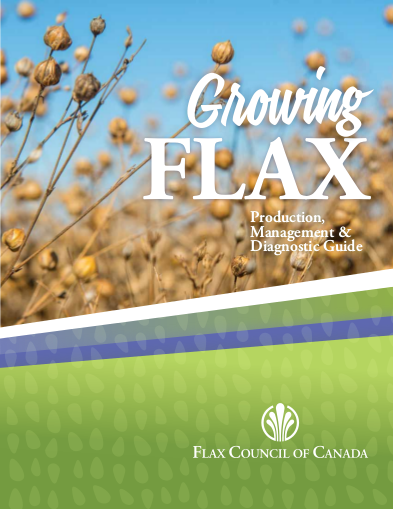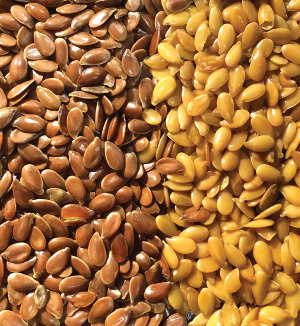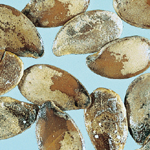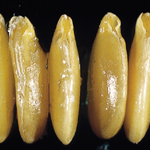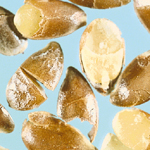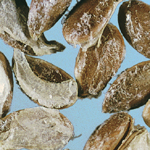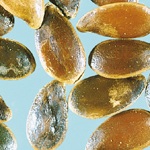Chapter 2: Seed and Seeding Practices
Chapter 2 – PDF version
Download the PDF version of ‘Chapter 2: Seed and Seeding Practices’.
Step 1–Choice of Seed
The use of certified seed of a suitable variety (see Photo 2-1) is recommended. Certified seed is tested to ensure genetic purity, good germination, minimal weed seed content and consistently yields better than farm-saved seed, producing a higher net return from the crop.
Choosing good seed is critical for stand establishment. Reductions in plant stand and seedling vigour will occur if damaged seed such as cracked (see Photo 2-2), split (see Photo 2-3), blighted or mouldy (see Photo 2-4), shrivelled, weathered (see Photo 2-5), or frozen seed (see Photo 2-6) is used. Seedlings with inadequate vigour tend to be negatively affected by the previous season’s growing and harvesting conditions, as well as by soil pathogens. Seedlings produced from damaged seed may germinate very slowly and may also have injured root tips, broken or cracked cotyledons, split hypocotyls, twin radicles, radicles trapped inside the seedcoat and roots that are blunt, broken, long and spindly, or gnarled and distorted. All of these conditions may affect stand establishment and can reduce overall yield.
The flax seedcoat is fragile and can be damaged mechanically when flax is threshed at excessively high cylinder speed, low concave clearance, combined when seed is too dry, or from a combination of any of these. Large seeded varieties may be more prone to cracking than small seeded varieties. Split seed occurs when the two halves of the seedcoat become separated at the small end, exposing the embryo to soil microorganism invasion. This condition starts in the immature boll as the seed develops and is more likely to be seen with yellow seedcoat varieties. Blighted seed is often the result of weathering and may appear discolored (dull grey to black) or shrivelled. If harvest is delayed and the field is subjected to repeated high moisture conditions over the harvest season, the seedcoat often has a rough texture due to adherence of boll tissue. Other conditions that may contribute to blighted seed include drought during grain filling and disease. The pathogen Alternaria can colonize seeds under high moisture conditions during harvest and this may result in black discoloration of the seed. When Alternaria infested seed is sown the following year, the pathogen colonizes the seedling and may eventually kill it. If seed has shiny black discoloration, then it likely has been frozen and will not germinate.
Step 2–Seedbed Preparation
Flax requires a well prepared, firm, relatively even and moist seedbed for maximum emergence. Preparation for planting begins by reviewing the previous crop grown and herbicides used. Deciding when and where to grow flax in your rotation should be made on the basis of weed management and maintenance of soil organic matter. Flax has been found to have equal or better yields under reduced tillage (minimum or zero till) versus conventional tillage systems. This has been attributed to improved soil organic matter, increased soil moisture availability and increased arbuscular mycorrhiza colonization and rooting capacity despite reduced emergence commonly experienced under reduced tillage systems. Another advantage to minimum and zero tillage is a reduction of early weed emergence compared with conventional tillage systems.
If tillage is being used, then the land should be worked to minimize soil drifting and to ensure effective snow trapping. If spring tillage is required, it should be shallow in nature in order to maintain a firm seedbed. The effect of pre-seeding tillage in terms of the type of implement, the depth of tillage and the effect of packing either before or after seeding is not clearly defined. Research from the University of Alberta has shown that deeper tillage reduces stand establishment and that packing before or after seeding may be required.
Regardless of whether conventional, minimum or zero tillage is being used; sow the seed soon after the land is worked, before the soil dries out and before weeds seeds have a chance to germinate. Winter annual weeds, such as stinkweed, flixweed and shepherd’s purse should be controlled using recommended herbicides in the previous fall or early spring (pre-plant or pre‐emergent).
Step 3–Plant Stand Establishment
Good plant establishment is critical to attain high yield and high quality seed. A minimum plant population for optimum yield is 300 plants per square meter, unless grown under irrigation. Yield potential is reduced when plant stands are less than 300 plants/meter2 (~300 plants/yard2 ). Plant stands above 400 plants/meter2 (~400 plants/yard2 ) do not necessarily increase yield and may actually predispose the crop to lodging (see Photo 2-7). For maximum yield, farmers should generally seed between 40 and 45 kg/ha (35 and 40 pounds/acre). If seedbed conditions are poor, slightly higher seeding rates may help ensure adequate stands. Seeding rate should be adjusted on the basis of seed size, percent germination and soil fertility. When optimal, higher plant populations can take advantage of exceptional growing conditions. Yellow seeded varieties should be seeded at a slightly higher seeding rate, particularly if seed treatment is not used.
Higher yield potentials are common under irrigation and under these conditions, higher seeding rates such as 50 kg/ha (45 pounds/acre) may prove beneficial. Under high soil fertility or where crops are grown under irrigation, it is extremely important to choose a flax variety that has good lodging resistance, as both high soil fertility and increased moisture conditions increase the potential for lodging. Severe lodging in flax may reduce yield by 30%, whereas severe lodging in cereals may reduce yield by half that much. While flax is not prone to Sclerotinia stem rot, sclerotinia can occur under lodged conditions where flax stems are in contact with the soil. Under this situation, flax straw is usually inferior for fibre utilization.
Flax has relatively small seeds which do not have sufficient food reserves to overcome deep seeding or soil crusting. However, these small seeds are prone to drought if planted too shallow. Soil crusting may occur particularly with rainfall soon after seeding or on soils with high clay content and this may result in poor stands and reduced yield potential. Flax should be sown into moist soil, 2.5 cm to 4.0 cm (1.0 to 1.5 inches) deep with row spacing 15 to 20 cm (6 to 8 inches). Compared to that of other crops, flax seedlings are weaker and shallow seeding depth is more critical. Deeper seeding or seeding in soils that are prone to crusting should be avoided whenever possible as emergence will be decreased and delayed, resulting in weaker seedlings and reduced stands that would be prone to excessive weed competition, injury by herbicides and disease.
If stands are thin, a decision must be made whether or not to reseed. Flax seedling emergence is sometime poor due to the use of damaged seed, soil crusting, seedling diseases, adverse weather conditions, deep seeding, herbicide injury or other reasons. Generally, reseeding reduces yield potential as the early seeding advantage is lost and soil moisture is reduced from additional tillage. The added costs of reseeding must also be taken into account.
Seeding Date
Early seeding produces greater and more reliable yields, better control of later emerging weeds and reduces the risks of disease and insects. Additionally, it reduces the risk of damage caused by early fall frosts. Generally, flax that is sown in early to mid-May results in maximum yield and minimal harvest challenges. Flax may be sown up to June 1 with reasonable yield expectations. Seeding flax after June 1 lowers yield potential and increases harvest challenges as the crop would be maturing under cooler, wetter and shorter days. In part, this can be attributed to the fact that when seeds are planted earlier, moderate temperatures and ample soil moisture during flowering and seed development will favour high yield, oil content and oil quality. As well, seeding in mid-May generally results in high quality straw. In contrast, seeding after June 1 usually results in decreased yield, increased lodging, lower oil content and lower oil quality. Green stems and secondary growth are also more prevalent under late seeding conditions and may lead to difficulties in harvesting. Some flax varieties perform better than others under late seeding conditions and use of these varieties under these conditions is advised.
Flax plants just emerging (cotyledon stage) are the most susceptible to early spring frost, but can withstand temperatures down to approximately -3° Celsius. After the seedlings have passed the two leaf stage and are hardened by exposure, they can withstand temperatures as low as -8°C for a short time, without significant damage.
Production Tip
Use good, preferably certified, seed of a recommended variety.
Water Use and Irrigation
Flax is a good fit in many irrigated crop rotations. It can quite reliably produce high yields and it is less susceptible or resistant to many of the specific diseases and pests that attack other important irrigated crops. Examples of pests in other crops include Sclerotinia stem rot, blackleg, clubroot, flea beetles, and the specific species and strains of Fusarium that cause Head Blight in cereals and wilts in other crops. Flax has generally been grown on one to several percent of the irrigated cropland in Alberta and Saskatchewan. The number of flax acres under irrigation varies with price and its perceived profitability in relation to other crop choices. Irrigation results in heavier crop stands that are more prone to lodging. To mitigate this, cultivars with good lodging resistance should be selected and excess nitrogen fertilization should be avoided.
The root mass of flax is among the lowest of all Prairie field crops. Also, the proportion of flax roots below 60 cm (and especially 80 cm) depth is lower than other field crops, except pea and lentil. Therefore, the depth of soil moisture management for flax irrigation should be somewhat shallower than cereals and canola, but deeper than beans or potatoes; 60-80 cm is suggested, depending on soil type.
Market News
Over the past two years and ending with the 2014/15 crop year, Canadian flax production has averaged 810,000 tonnes (31.9 million bushels) per year, confirming Canada as a major contributor to world flax production.
Production Tip
Sow clean, sound seed; treat the seed with a recommended fungicide.
Irrigating prior to crop emergence can cause soil to wash in over the seed row and may promote soil crusting and result in poor and/or uneven stands. When it is necessary to raise soil moisture for germination, irrigating prior to seeding is preferred for small-seeded crops like flax.
Production Tip
Prepare a firm, weed-free, and moist seedbed.

